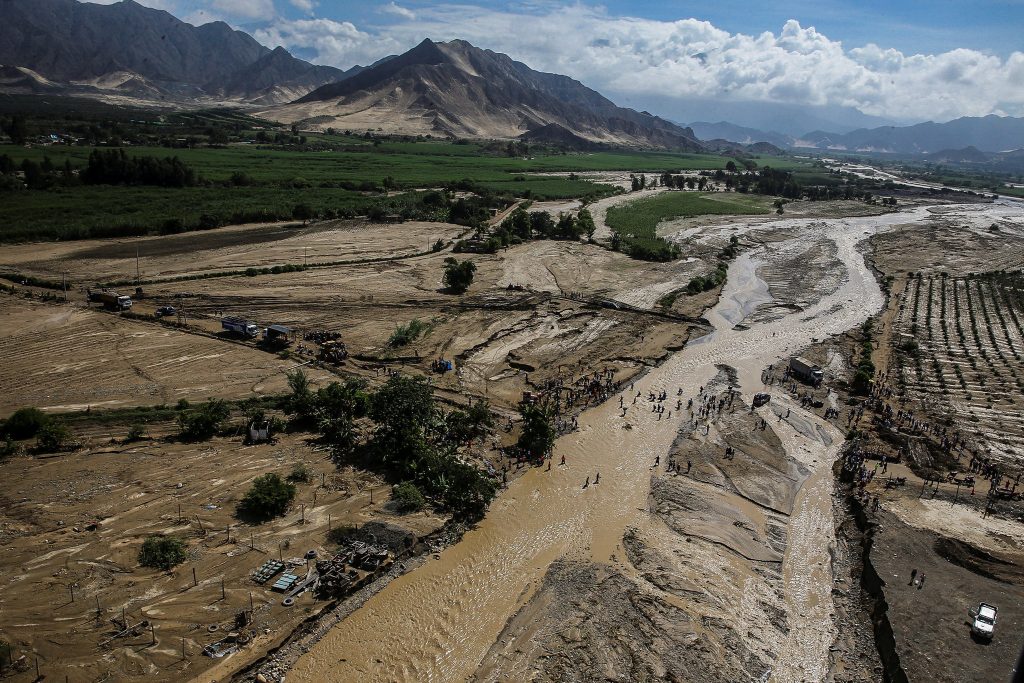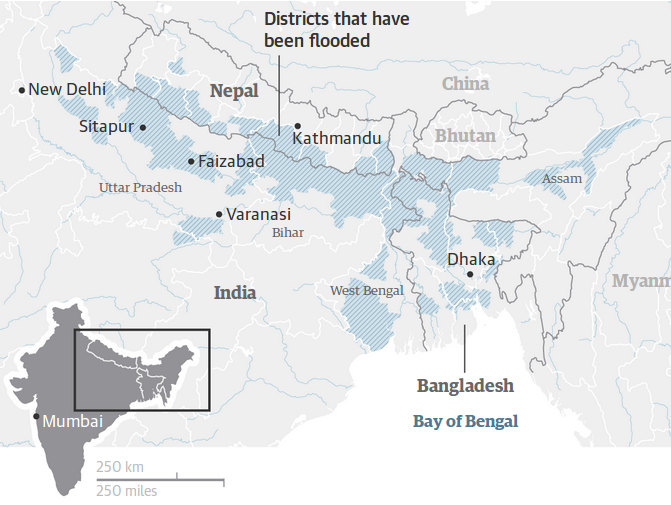This post gives a list of web-based sources that publish disaster information suitable for monitoring. This implies that the information is provided near real-time, often unverified and mostly very redundant between sources. Some sources also publish analyses and well-documented post factum quantitative analyses. The second half of the post presents some recent summary documents showing that we are in for more disasters, and that their magnitudes are likely to keep growing.
Definition
What is a disaster? There is a lot of confusion in the public about disasters. Some say a cyclone or an earthquake are disasters. They are not: they are extreme geophysical factors that interact with a vulnerable “system” such as human society or a power distribution network. The disaster is the impact, i.e. it is the “memory” which the vulnerable system has of the impact, the changes that occurred in the system because of the extreme factor. Related terms are “vulnerability” and “risk” as well as “extreme factors” which are often used incorrectly… but let us come back to disasters.
How serious is a disasters?

Floods and landslides in early 2017 in Trujillo, Peru. Source: https://globalrumblings.blogspot.it/2017/04/floodsmudslides-disasters-death-toll.html
Disasters occur continuously. Not all of them are spectacular but all of them cause a lot of suffering and losses of food, assets or income. The most dramatic situations develop where countries struggle with emergencies that eventually become chronic, i.e. disasters occur repeatedly in the same places because they can no longer cope and protect themselves. Chronic problems are often referred to rather euphemistically as “structural” (Note 1). This is why the sources of disaster information listed below keep mentioning the same areas, to the extent that it is often difficult to decide how serious the impacts have been. This is particularly difficult for near real-time monitoring, when damage has not yet been assessed correctly.
Early estimates are, almost as a rule, underestimates. The “standard” disaster data base of CRED for instance, is perfect for long-term statistics, but it is updated with a delay that prevents its use in monitoring situations. A recent survey by IRIN (IRIN 2018) assesses the coverage of humanitarian crises by mainstream media, and finds it to be “selective, sporadic, simplistic and partial.” This may be so indeed, but it easily explained by the appeal of the catchy and spectacular: large floods, fires, volcanic eruptions and the like, regardless of their actual short and especially long-term impacts are good food for news. I remember late 1990s Zambezi floods where South-African army helicopters were shown rescuing people who had taken refuge on the roofs of their houses. Flooded houses and crops are dramatic enough, but they make for excellent news (and propaganda for the humanitarian intervention of South Africa military). Objectively, however, floods are an accumulation of water in low lying areas, which means that abundant rainfall was recorded in upper portions of the basin, which are considerably larger that valley bottoms. It is in the upper portions of the basin that crops suffer most from soil water logging and root asphyxiation. This is rarely documented. A good example in point regards the 1993 Mississippi floods where about three quarters of the damage occurred because of soil water logging due to excessive rain in non-flooded areas (IFMR, 1994).

Flooded areas in India, Nepal and Bangladesh as of 29 August 2017. Source: https://www.theguardian.com/world/2017/aug/30/mumbai-paralysed-by-floods-as-india-and-region-hit-by-worst-monsoon-rains-in-years
List of sources suitable for monitoring
As IRIN noted, the “mainstream media” are not the best source for disaster information, but they are nevertheless a source, of which the Guardian present a systematic, chronological and useful overview. Wikipedia also has excellent and systematic information on tropical cyclones (hurricanes, typhoons).
For less anecdotal information, the sources below need to be resorted to. Most of them provide the option to subscribe to email alerts or summaries.
- ACAPS (Assessment Capacities Project) is an NGO funded by the Norwegian Refugee Council and Save the Children;
- GDACS (Global Disaster Alert and Coordination System) is funded by the UN and the European Commission;
- HDX, the Humanitarian Data Exchange, managed by OCHA;
Humanitarian Response is another service provided by OCHA to support humanitarian response through the sharing of operational information; - IFRC, International Federation of Red Cross and Red Crescent Societies based in Switzerland
- The International Charter Space and Major Disasters was established in the wake of the 1999 UNISPACE conference by the European Space Agency (ESA), the French space agencies (CNES), soon joined by the Canadian Space Agency (CSA) in 2000. The Charter had 17 members in 2018 when it was joined by the United Arab Emirates Space Agency (UAESA). The Chartwer aims at assisting relief organizations with satellite imagery.
- IPC (Integrated Food Security Phase Classification) is a partnership of fifteen aid and development agencies (from Action Against Hunger and Care to UNICEF and the WFP) funded by ten national and multilateral development agencies;
- IRIN (Integrated Regional Information Networks) was originally sponsored buy the UN but became an independent, non-profit media venture in 2015. It is funded by a mix of governments, foundations and international organizations;
- OCHA (United Nations Office for the Coordination of Humanitarian Affairs);
- RedHum (Spanish for “Humanitarian Network”) provides information about emergencies in Latin America and the Caribbean. It is managed by OCHA and ReliefWeb;
- ReliefWeb is another information system funded by OCHA
- UNOSAT is a UN service provided by UNITAR to assist development and relief organizations with satellite imagery
In addition to the specialised sources listed, UN organizations also provide good thematic information. FAO, for instance, has impacts of extreme events on agriculture; UNICEF focuses on disasters as they affect children and UNHCR systematically assesses movements of people displaced internally and internationally. The agencies also publish analyses of current situations and trends, as for instance the recent FAO report “2017 The impact of disasters and crises on agriculture and food security” (FAO, 2018).
Disasters trends
According to a recent international database of disasters assembled by a team based at the Karlsruhe Institute of Technology in Germany (Daniell et al 2016), between 1900 and 2015 about 35,000 extreme events have caused the death of 8 million people and economic losses equivalent to US$ 7,000 billion. Just over 50 percent of losses are associated with water (floods and drought), which is consistent with recent insured losses data regularly reported by the insurance industry. Over the same period, the number of casualties due to man-made disasters (the many variants of declared and undeclared “war”) is 10 tp 20 times larger. The authors of the study suggest that, in relative terms, the impacts of disasters have decreased over the century, which is no doubt due to improved legislation and better preparedness and warning systems.
A report issued earlier this year by the European Academies Science Advisory Council (EACSAC 2018) notes that global floods and extreme rainfall events have increased more than 50% this decade. The increase is more than fourfold when compared with 1980. For abnormally high temperature, of which agricultural drought and fires are a usual consequence, the increase over 1980 is more than twofold. While the scientific community has been very cautious in assigning recent extreme events to climate change, the EACSAC report asserts that “most of the changes can now be clearly assigned to climate change and resulting deep impacts, e.g. on ocean currents” (see also Stott, 2016)
There is growing evidence that the heat waves and tropical cyclones (which are “fed” by warm ocean surface temperature) are indeed a consequence of global warming. At the end of October 2017, WMO issued a statement confirming that 2016 witnessed a new record average atmospheric CO2 concentration at just above 400 ppm, about 1% higher than 2015 values. The report states that since 1990, there has been a 40% increase in total radiative forcing, i.e. the warming effect of greenhouse gases on climate. In a recent 2017 publication in Nature Climate Change, Mora and his colleagues found 783 cases of excess human mortality associated with heat from 164 cities in 36 countries between 1980 and 2014. The authors found that around 30% of the world’s population is currently exposed to climatic conditions exceeding a lethality threshold at least 20 days a year. By 2100, this percentage is projected to increase to about 50% if GHG are drastically reduced and to about 75% under a GHG growth scenario.
The areas likely to be worst affected include northern India, southern Pakistan and Bangladesh, which are currently home to 1.5 billion people: in another 2017 article in Science Advances, Mazdiyasni and his co-authors found that western India experienced 50% more heat waves and heat-related mortality during the period 1985–2009 than during the previous 25-year period. The authors suggest that even moderate increases in mean temperatures, such as 0.5°C, are bound to increase heat-related mortality, unless measures are taken to substantially improve the resilience of vulnerable populations. The urgency of taking measures is also underlined in the latest report of the Global Challenges Foundation, which finds that, collectively, we significantly under-invest in global catastrophic risk reduction. On a low-medium emissions scenario, there is at least a 3% chance of eventual 6°C warming (with significant uncertainty). On the medium-high emissions scenario, the chance could be around 10%.
The recent report on the Global Hunger Index (GHI), the inequalities of hunger published in October 2017 by the International Food Policy Research Institute, Concern Worldwide and Welthungerhilfe lists several countries where the GHI varies between alarming and extremely alarming, including Sierra Leone, badly affected by a series a mudslides, Yemen, Chad where unrest and floods were reported recently, as well as Madagascar (listed below) and the Central African Republic (CAR). Some countries, such as the CAR have been at a very low GHI score for more than a decade.
Notes
Note 1: FAO, for instance, refers to structural food insecurity when a country has reached a stage where it no longer can feed itself during average years. See, for instance, this or this link.
References
Daniell J, F Wenzel, Andreas Schaefer 2016 The economic costs of natural disasters globally from 1900-2015: historical and normalised floods, storms, earthquakes, volcanoes, bushfires, drought and other disasters. Geophysical Research Abstracts 18:EGU2016-1899.
EASAC 2018 Extreme weather events in Europe, Preparing for climate change adaptation: an update on EASAC’s 2013 Study . 6 pp.
FAO 2018 2017 The impact of disasters and crises on agriculture and food security. FAO, Rome, 143 pp. http://www.fao.org/3/I8656EN/i8656en.pdf.
IFMR, 1994. Sharing the challenge: floodplain management into the 21st century. Report of the Interagency Floodplain Management Review Committee to the Adminstration Floodplain Management task Force, Washington.
IRIN 2018 Mainstream media coverage of humanitarian crises falls short, new survey finds
Mora et al. 2017, Global risk of Deadly heat. Nature Climate Change, 7, 501–506
Mazdiyasni et al., 2017. Increasing probability of mortality during Indian heat waves. Science Advances, 3:e1700066
Stott P 2016 How climate change affects extreme weather events. Research can increasingly determine the contribution of climate change to extreme events such as droughts. Science 352(6293):1517-18.
this
this